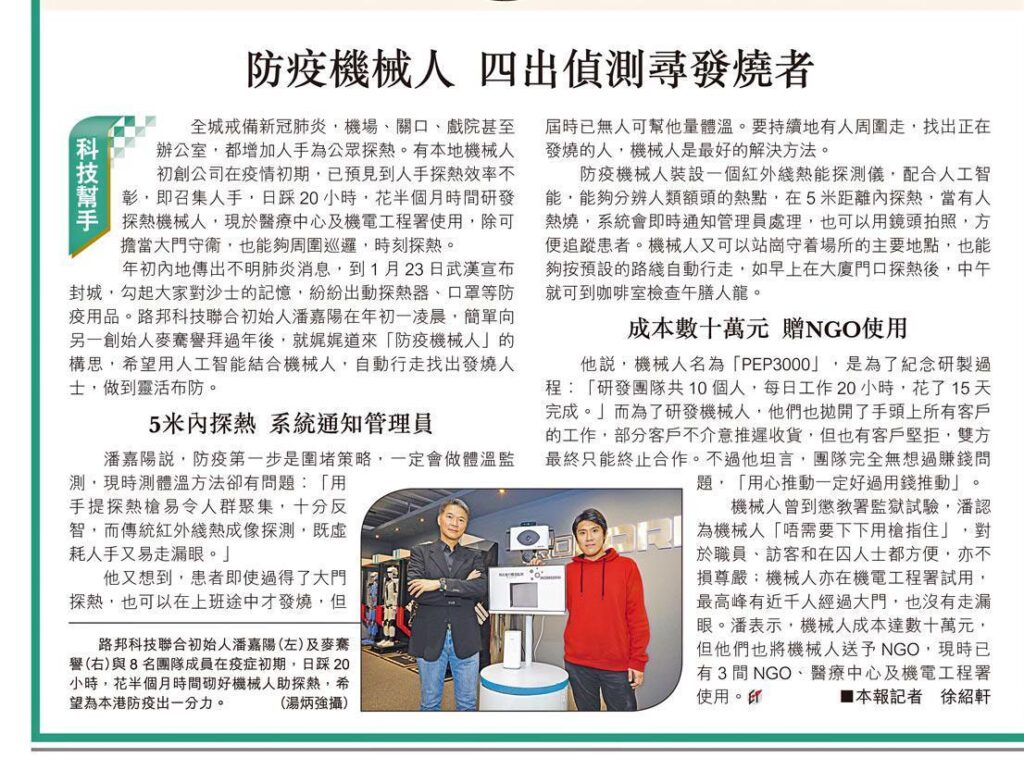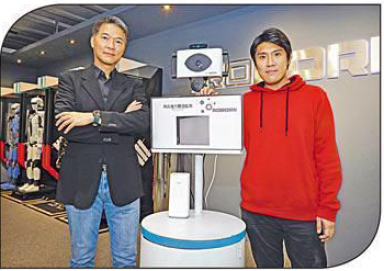(Below is a translation of the article.)

The city is on high alert with the novel coronavirus. From the airport to the customs, from cinemas to offices, these places have increased manpower to detect body temperatures of the public. At the beginning of the epidemic, a local robotics startup company had already foreseen the lack of efficiency in manual body temperature detection. The company immediately gathered all hands on deck. Working 20 hours each day, they developed a temperature detection robot in half a month. The robot is currently used at a medical centre and the Electrical and Mechanical Services Department. Apart from acting as the gate guard, the robot can patrol around and detect temperatures at all times.
The news of the unknown pneumonia broke out from mainland at the beginning of the year. On January 23, Wuhan announced the lockdown of the city. These reminded everyone of the SARS and they brought out their epidemic prevention supplies such as thermometers and masks. In the wee hours on the first day of Lunar New Year, Poon Ka Yeung, Roborn Technology’s co-founder, began to illustrate his idea for an “epidemic prevention robot”after briefly exchanging New Year’s greetings with the other co-founder Mak Hin Yu. He hoped to combine artificial intelligence with the robot, which can move around automatically to identify people with fever and achieve agile deployment.
System detects body temperature within 5 meters and notifies administrator
According to Poon, the first step to epidemic prevention is containment strategy. Body temperature monitoring is a must. However, current methods of measuring body temperature are problematic, “The use of hand-held thermal probes easily causes people to gather, which is very anti-intellectual. As for traditional thermal imaging detection, it wastes manpower and misses targets easily.”
He also thought that even the patient passes the temperature detection at the gates, he could have a fever during work, but no one could help him take his temperature by then. There needs to be a person who can move around constantly in order to find out the feverish person. Therefore, the robot is the best solution.
The epidemic prevention robot is equipped with an infrared heat detector. With artificial intelligence added, it can identify the hotspots on human foreheads and detect temperature within five meters. When someone has a fever, the system will immediately notify the administrator for further actions. It can also take photos through the lens for tracking patients conveniently. The robot can stand guard at main locations of a place and navigate itself according to a pre-set route. E.g. after detecting temperature at the building entrance in the morning, it can then detect the temperatures of the people lining up for lunch in the café in the afternoon.
Robot costed 100K and was gifted to NGO
He said the robot is named PEP3000 to commemorate the development process, “It took our R&D team of ten 15 days of work, 20 hours each day to complete the robot.”In order to develop the robot, they had to put aside all customer work. Some clients did not mind the postponement of deliverables, but some clients refused so both parties can only terminate their cooperation. However, he admitted that the team never thought of making money, “It is better to be motivated by heart than money.”
The robot has been tested at prisons of the Correctional Services Department. Poon believed that the robot “doesn’t need to point with a gun at all times”. This will be more convenient for staff, visitors and prisoners and their dignity will not be harmed. The robot is also tested at the Electrical and Mechanical Services Department (EMSD). At the highest peak, nearly a thousand people passed by the entrance and not a single person was missed. Poon said the robot costed them up to 100K, but they also donated the robot to an NGO. At present, the robot is being used at three NGOs, a medical centre and at EMSD.


